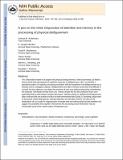A Pox on the Mind: Disjunction of Attention and Memory in Processing Physical Disfigurement
Author(s)
Ackerman, Joshua; Vaughn Becker, D.; Mortensen, Chad R.; Sasaki, Takao; Neuberg, Steven L.; Kenrick, Douglas T.; ... Show more Show less
DownloadAckerman_A pox.pdf (199.2Kb)
OPEN_ACCESS_POLICY
Open Access Policy
Creative Commons Attribution-Noncommercial-Share Alike
Terms of use
Metadata
Show full item recordAbstract
The unfavorable treatment of people with physical disfigurements is well-documented, yet little is known about basic perceptual and cognitive responses to disfigurement. Here, we identify a specialized pattern of cognitive processing consistent with the hypothesis that disfigurements act as heuristic cues to contagious disease. Disfigurements are often invariant across time and difficult to conceal, and thus observers can detect the presence of such cues without necessarily remembering the particular individuals bearing these cues. Indeed, despite the fact that disfigured faces were especially likely to hold disease-sensitive perceivers’ attention (Study 1), disfigured individuals were often confused with one another and thus not well remembered later (Study 2), revealing a disjunction of the typical relationship between elevated attention and elevated memory. We discuss the implications of our results for stigmatization of people with and without physical abnormalities and suggest the possibility that cognitive mechanisms for processing social information may be functionally tuned to the variant nature of important cues.
Date issued
2009-01Department
Sloan School of ManagementJournal
Journal of Experimental Psychology
Publisher
American Psychological Association (APA)
Citation
Ackerman, Joshua M. et al. “A Pox on the Mind: Disjunction of Attention and Memory in the Processing of Physical Disfigurement.” Journal of Experimental Social Psychology 45.3 (2009): 478–485.
Version: Author's final manuscript
ISSN
0022-1015